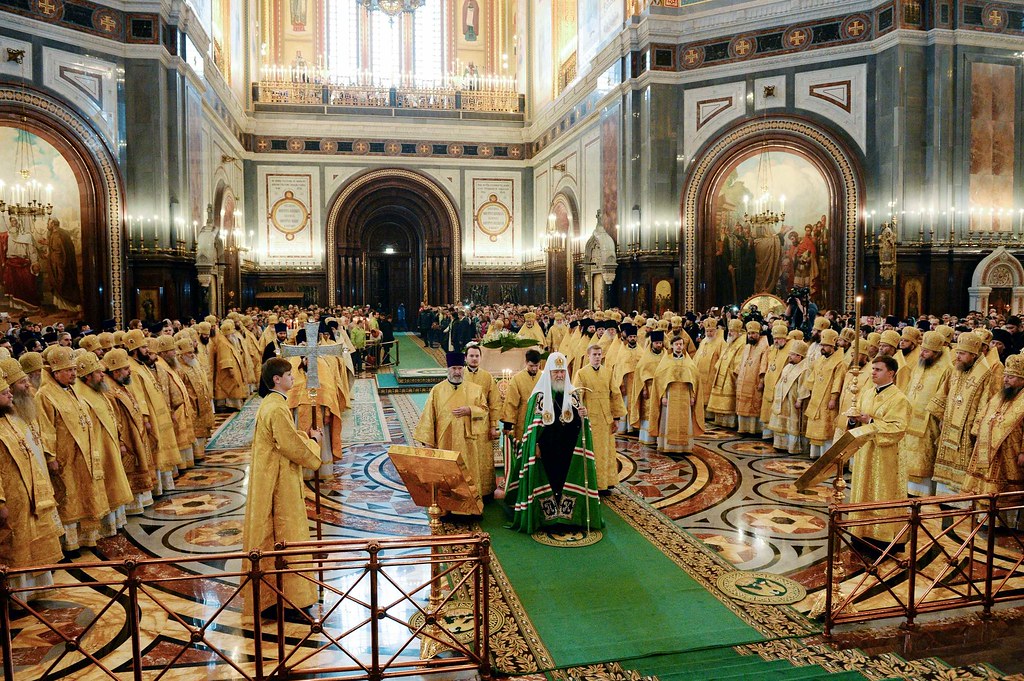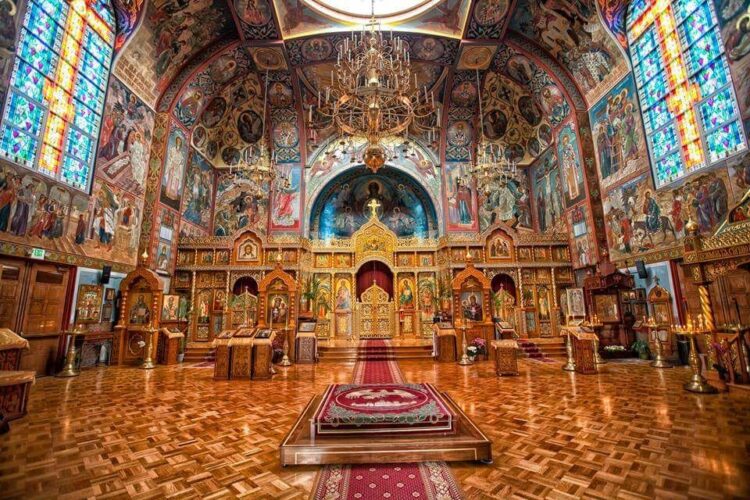New Battle Over Ortodoxy and the biggest schism in Christianity in centuries
Recently international media has been dominated by the hot topic of Russia expanding its role in global politics. However there is currently one geopolitical battle that is barely noticeable to the mainstream media. What it involves is redistribution of spheres of influence in the Orthodox world. Until recently the Russian Orthodox Church (ROC) looked like an indisputable global hegemon among all Local Churches, while Metropolitan Cyril met on equal terms with the Pope of Rome. Today, the power of the Russian Orthodox Church has been sorely challenged that can lead to schism in the Orthodox world.
Processes unleashed by events in Ukraine, when the Patriarchate of Constantinople, contrary to the view of ROC and the Ukrainian Orthodox Church of the Moscow Patriarchate (UOC-MP) that until now form the majority of believers in Ukraine, initiated the process of recognition of uncanonical church groups – Patriarch Philaret of Kiev (Denisenko) and the minor UAOC (dating back to the self-declared organizations of the Civil War).

The UOC headed by the young Metropolitan Epiphany (Dumenko) – the pupil of Philaret – was created on the basis of the two above mentioned structures and on January, 6, 2019 was granted the “Tomos of Autocephaly” (a decree of canonical independence) by the Patriarch of Constantinople. The position of the Patriarchate of Constantinople is simple and straightforward – whatever is recognized by the Patriarchate of Constantinople is considered legal, by definition, and the Archbishop of the “New Rome” (part of the official tittle of Patriarchs of Constantinople) holds primacy in all Orthodox churches and his authority extends far beyond the limits of his jurisdiction.
It was an insolent challenge to the Russian church that for centuries was claiming to be the heiress of Great Rome and the main center of “Eastern Christianity”.
Ambitions of the Russian Orthodox Church suffered two precise and very painful blows: first, the UOC was recognized by Hellenic (Greek) Orthodox Church, and then by the Patriarchate of Alexandria, the second “highest-ranking” patriarchate in the World Orthodoxy.
As a result of the current events debates on Orthodox canons have moved from academic and church circles to the global media and from the preserve of highly specialized experts and admirers of antiquities turned into an aspect of geopolitics. Let us try to look into the nature of primacy of the Archbishop of Constantinople in the Orthodox world and anticipate scenarios that we can possibly face.
New Rome as the capital of “the Universe” and primacy of honor
In 330 the Emperor Constantine the Great moved the capital of the Roman Empire to the small city of Byzantium in Eastern Thrace. The city was rebuilt and named “the New Rome” (together with the official name almost immediately it acquired a semi-formal name — “the City of Constantine” or Constantinople).
In legal terms, New Rome gained all the privileges of the former capital. Shortly after the Episcopal Department established here received “primacy of honor” and became the second on the list of episcopal departments of the Empire after “ancient Rome”.

Emperor Constantine the Great
According to the II Canon adopted at the Second Ecumenical Council in Constantinople, “the bishops are not to go beyond their dioceses to churches lying outside of their bounds”.
Nonetheless regardless of this Canon during the IV-V centuries, practically all “local” churches of the Empire were consolidated around the four main political centers — Rome (West of the Empire), Alexandria (African provinces), Antioch and Jerusalem (shared administrative units located in Asia).
That is when the term “autocephaly” appeared to deternine some special status of certain churches. This term is not mentioned in conciliar documents; however, since VI century it is found in various church and secular documents of the Empire and has at least several different meanings. The term, for example, refers to the church of Cyprus, that enjoyed independence of patriarchs of the Pentarchy that was granted to it by the Emperor.
«Roman” Patriarchate and parade of autocephalies
In 1453 started a new chapter in the history of the “World Orthodoxy”.
The fall of Constantinople and the consolidation of territories of all the patriarchates of the former Byzantium under the rule of the Ottomans made significant adjustments to the administrative structure of the Orthodox Church within the borders of the Ottoman Empire.
Thus, for the first time in history, the “ecumenical” title of the Patriarch of Constantinople gained some meaningful and understandable administrative and legal characteristics with highly structured hierarchy. It is clear that in such circumstances there could be no question of any conciliarity, although initially this state of affairs was seen by the patriarchs of Constantinople as an involuntary, temporary measure.

Ancient Constantinople
At the same time, Orthodox churches that remained outside the Ottoman Empire actually distance themselves from the churches of the Pentarchy that fully integrated into the Ottoman state. The Russian Church was the largest among the decentralized churches. Since the Baptism of Russia in the X century, it was a Metropolis within the Patriarchate of Constantinople, and became de facto self-governing since 1448, shortly before the final fall of Byzantium.
Aa a result of further development and strengthening of the Russian state with its center in Moscow, alongside with the ongoing decline of the Orthodox Church within the borders of the Ottoman Empire, in 1589 the Russian Church by the mediation of secular authorities was granted the status of the Patriarchate by Constantinople that was later confirmed by other «Eastern patriarchs.»
Subsequently, this status, coupled with the power of the Russian Empire, ensured a dominant position of the Russian Church on the world stage. Practically it absorbed the functions of the Ecumenical Patriarchate and basically supported on its own the interests of the Orthodox Christians in the territory of former Byzantium.
Through a series of Russian-Turkish wars the Orthodox people in Greece (1833), Romania (1877), Bulgaria (1878) and Serbia (1879) gained independence. Soon after becoming sovereign states, or shortly before that these states were granted ecclesiastic autonomy.
Two of the above-mentioned churches – Bulgarian and Serbian – had already experienced autonomy and enjoyed the status of patriarchates in different periods of the existence of the Byzantine Empire.
Apart from the national liberation impulse, the necessity to proclaim independence of the Church resulted from the fact that the Ottomans often used the Patriarch of Constantinople to pressure the Orthodox population of the Empire, demanding to put down liberation movement on the periphery by any means.
Thus, by order of the Sultan, the patriarchs of Constantinople often excommunicated those laypeople who participated in the movement and deposed the hierarchs who supported them. Therefore, church autocephaly removed from the agenda the question of administrative subordination to the patriarch of Constantinople, who was completely dependent on the Sultan.
The reaction of the Patriarchate of Constantinople to requests for church independence, however, was often a lot tougher than that of the Ottoman Porte. The textbook example for a schism, created as a result of the problem of autocephaly, is the Bulgarian schism of 1872. In an attempt to confront the autocephaly of the Bulgarian Church Patriarch Gregory VI even tried to convene the Ecumenical Council, however he faced lack of understanding on the part of the Sultan and objection of the Holy Synod of the Russian Orthodox Church. As a response, at the Council that ultimately was convened (though of a significantly lower scale), the Hierarch of Constantinople and patriarchs of Alexandria, Antioch, Jerusalem and the archbishop of Cyprus that in fact were subordinate to him, denounced the “Bulgarian Schism” and excommunicated its participants, in other words basically the entire Bulgarian church.
The autocephalous Bulgarian Church was recognized by Constantinople as late as in 1945, facilitated by the Russian Orthodox Church and personally Patriarch Alexey (Simanski). However, this was already the time when Phanar shifted his policy from opposition to independence of his former national metropolises towards the proclamation of the ecumenical (in the modern sense of the word) nature of the authority of the Bishop of Constantinople in relation to all local Orthodox churches, as well as to undivided dominance in the Orthodox diaspora.
The current events around the Ukraine Church were the logical continuation of this policy, directly confirming the claims of Constantinople, which, in its turn, has gone all-in and, quite obviously, is determined to break all those in disagreement on the way to restore its former privileges. The news of the UOC recognition by the Patriarchate of Alexandria is a perfect example. It is amazing how carefully everything was done – not a single insider, nor analyst, even the most pro -Ukrainian, could predict this. It was something more of a special operation. Everyone talked about the UOC to be possibly soon recognized by the Romanian or the Cypriot Church, but no one could ever expect that Alexandria would be next. Apparently, this Patriarchate had been chosen as the most “pro-Russian” (from the point of view of the attitude of its primate towards Russia and the Russian Church) in the Greek world.
Obviously, the situation in world Orthodoxy is developing according to the scenario of targeted pressure through compromising material on church primates (We do not dare to allege this, but apparently, there could have been some compromising evidence -real or imaginary – on the Patriarch Theodore as well). The situation will unfold chaotically. Most likely, political factors of influence on a given church by key interest groups along with the personal position of primates (many of which are seriously concerned by the actions of the Patriarchate of Constantinople) will therefore be crucial.

Short forecast
As it has been mentioned above, the current situation in world Orthodoxy is becoming even less predictable. Nonetheless, we will try to look ahead and figure out a possible course of events. Generally speaking, now world Orthodoxy is present in countries that are not particularly friendly to Russia (with few exceptions). Georgia, Bulgaria, Romania, countries of the Greek World are almost completely dependent on Western centers of influence. The only exceptions are Serbia and Syria (the base country of the Antiochian Patriarchate, which is, in fact, mainly Arabic, from the point of view of its ethnic composition).
However, the Serbian Church has a considerable vulnerability — the status of churches in Macedonia and Montenegro. It is this point of concern that keeps it on a “short leash”, although many understand that Constantinople in any case is not likely to resolve the issue in favor of Serbia. It is only a matter of time. As for the Antiochian Patriarchate, the balance of power in the Middle East is making the situation here even more complicated. On the one hand, the Russian presence in Syria is a guarantee of a relatively acceptable level of stability and independence, on the other hand, Constantinople, following the “Ukrainian scenario”, poses a serious threat of taking away from it the Metropoles of the Lebanese Mountains —
an integral and very ancient part of it.
And although it all sounds more like fiction, about a year and a half ago the ongoing “Ukrainian scenario” seemed to be just as fantastic. We cannot also neglect the fact that the Patriarchate of Constantinople is now located in the territory of modern Turkey. It’s all a question of how long these churches and their leaders will be able to resist direct pressure from the global forces involved.
Another factor is Russian-Turkish collaboration on the Syrian issue and in general in the Middle East. There is every reason to believe that once again the West is playing the Greek-Turkish card against Russia. Actions taken within the “Greek line” can be explained by strong dissatisfaction with the “unacceptable” rapprochement between Turkey and Russia, and the world Orthodoxy, the original sphere of influence of the Greek, where Russia occupied a secondary position, has served as the main playground. It wouldn’t surprise me if a few decades later it will turn out that actions of the Greek Church were aimed at receiving West’s assistance in the implementation of the “Great Concept” of taking away part of Turkey’s western territories, primarily Istanbul, converting it back into Constantinople or transferring it to a sort of international jurisdiction. Does that sound like a fantasy? We live in an age of most unexpected events. At this point it is all bold thinking, reflecting on how global players managed to motivate the Greek. Anyways, Turkey should better give it a serious thought.

Mikhail Nesterov: The Vision of Young Bartholomew
As for world Orthodoxy, we can conclude that as a solid community it no longer exists. The Cyprus Church? Even most vague prospects of regaining Northern Cyprus can come to life. The Romanian Church? A chance that its jurisdiction in Moldova can be recognized by Constantinople makes it an ally of Phanar. The Georgian Church? Recent events in that country indicate that things got out of control. Patriarch Ilia II already lacks capacity, whereas the pro-Western party is a strong voice. The Bulgarian church? It depends completely on the State, that, for its part, depends heavily on Western centers of influence. The Patriarchate of Jerusalem? It is part of the Greek world, and its head is not known for showing much liking towards Russia. (Experience of the Patriarchate of Alexandria showed, however, that this is not a crucial factor). Constantinople has set the objective of forcing the Russian Orthodox Church to break off relations with all other local Orthodox churches.
The time has, therefore, come for the ROC to establish the format of «autonomous» existence. Some would call it isolation. Maybe. But to surrender will be a much greater evil. And the model of the world Orthodoxy proposed now by Constantinople, along the lines of the medieval Papacy will soon reach its limit – it is not like the old days. There is a view that formal unity should be replaced by a real, living Christian mission. It is the only way to bring world Orthodoxy up to date and to breathe new life into ancient foundations and rituals. In this regard the recent reunification of the Russian Orthodox Church with the parishes of the Archdiocese of Russian Orthodox churches in Western Europe is a symbolic event. The whole history of the existence of the Archdiocese is a successful experience of a Christian mission in the christian to its core Europe, of a living mission that reconciled ancient Orthodox legends and fine Russian traditions. For Russian Orthodoxy, current events are both an ordeal and a historical opportunity. The main thing now is to take this chance.
By Cezarium

Добавить комментарий
Для отправки комментария вам необходимо авторизоваться.